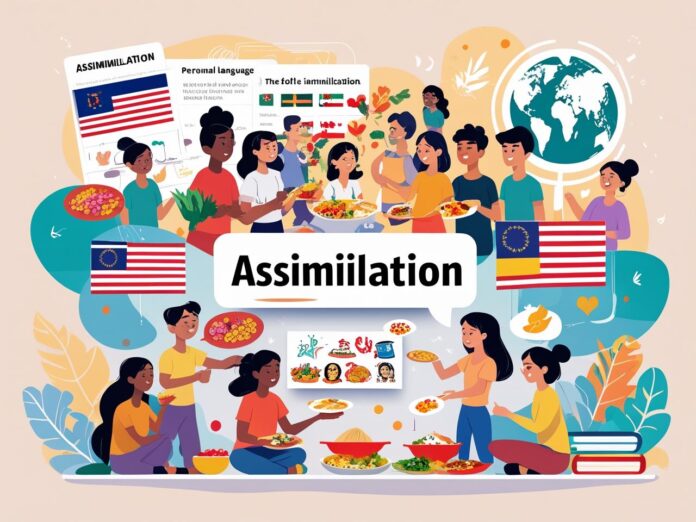Introduction to Assimilation
Have you ever wondered why people living in new countries often start picking up the local language, food habits, or traditions? That’s assimilation in action. In simple terms, assimilation is the process where individuals or groups adopt the culture, practices, and norms of another community. It plays a huge role in shaping modern society, especially in our globalized world.
History of Assimilation
Assimilation isn’t a new concept. Historically, empires and powerful nations encouraged or even forced assimilation of minority groups. For example:
-
The Roman Empire absorbed conquered people into Roman culture.
-
Indigenous groups in different continents were pressured to adopt colonial practices.
While some saw it as a path to unity, others criticized it as a way of erasing identities.
Understanding Assimilation
Assimilation can be broken down into three major types:
-
Linguistic assimilation – Adopting the dominant language of a community.
-
Cultural assimilation – Embracing local traditions, food, dress, and celebrations.
-
Social assimilation – Building relationships, participating in institutions, and blending into society.
The Psychology of Assimilation
On an individual level, assimilation is deeply tied to identity and belonging. Humans naturally want to fit in, and assimilation provides a pathway. However, it can also cause inner conflict when people feel torn between their roots and their new environment.
Importance of Assimilation in Human Development
Assimilation isn’t just about cultures—it starts early in life. Children assimilate knowledge in schools, adapting new ideas and ways of thinking. This helps them integrate into society and build essential life skills.
Cultural Assimilation
Cultural assimilation is most visible among immigrants. When moving to a new country, they often:
-
Learn the local language
-
Celebrate local festivals
-
Adjust their food preferences
At the same time, they try to preserve their own traditions, creating a unique blend of cultures.
Language and Assimilation
Language is one of the strongest tools of assimilation. Think about immigrants learning English in the U.S. or French in Canada—it opens doors to education, jobs, and social acceptance. Over generations, families may even stop speaking their native tongue, showing deep assimilation.
Assimilation in Education
Schools play a huge role in assimilation. Minority children often adapt faster by interacting with peers, learning new languages, and absorbing cultural values. However, they can also face challenges like identity loss or cultural pressure.
Assimilation in the Workplace
Workplaces are melting pots of cultures. Successful companies embrace assimilation through:
-
Diversity and inclusion programs
-
Cultural awareness training
-
Flexible policies that respect different backgrounds
This not only helps employees feel welcome but also drives innovation.
Advantages of Assimilation
Assimilation offers several benefits:
-
Social harmony – Reduces divisions and fosters unity.
-
Personal growth – Exposure to new ideas, opportunities, and experiences.
-
Economic benefits – Easier access to jobs and services for immigrants.
Disadvantages of Assimilation
On the flip side, assimilation can create challenges:
-
Loss of cultural identity – Traditions and languages may disappear.
-
Discrimination – People may be pressured to abandon their roots.
-
Pressure to conform – Individuals might feel forced to change who they are.
Assimilation vs. Multiculturalism
While assimilation encourages people to blend in, multiculturalism celebrates differences. For example:
-
Assimilation: Everyone adopts one dominant culture.
-
Multiculturalism: Different cultures coexist while keeping their uniqueness.
Both approaches have their pros and cons, and societies often try to balance the two.
Modern Examples of Assimilation
In today’s world, assimilation is seen in:
-
Fashion and food – Global brands influencing local cultures.
-
Technology – Social media spreading cultural norms.
-
Migration – Refugees and immigrants blending into host countries.
Future of Assimilation
With globalization, assimilation is becoming more complex. Instead of complete cultural absorption, future assimilation may look more like hybrid cultures—where people mix and match elements from multiple traditions.
Conclusion
Assimilation is a double-edged sword. While it promotes unity, opportunities, and growth, it also risks erasing unique identities. The challenge for modern societies is to find a balance where people can integrate while still celebrating their heritage.
FAQs
1. What is assimilation in simple words?
Assimilation is when people adopt the culture, language, and habits of another group.
2. Is assimilation good or bad?
It has both pros and cons—good for unity and opportunities, but risky for cultural loss.
3. How does assimilation affect identity?
It can help individuals feel included, but also cause conflict between old and new identities.
4. What is the difference between assimilation and multiculturalism?
Assimilation blends people into one culture, while multiculturalism allows multiple cultures to coexist.
5. Can assimilation happen naturally?
Yes, it often happens gradually through interaction, education, and daily life experiences.
